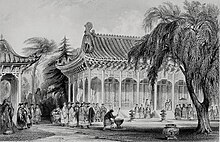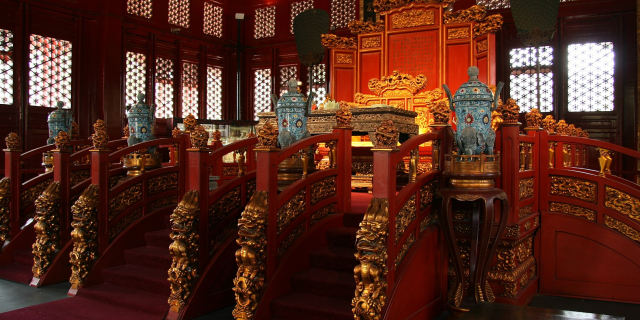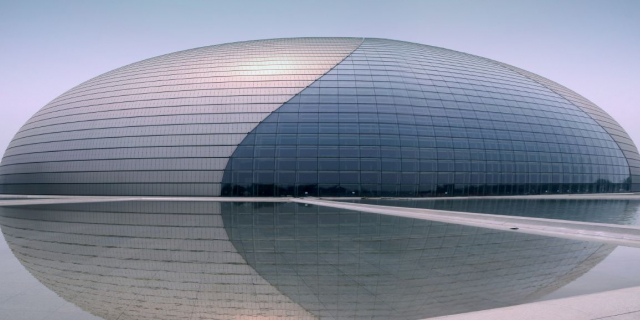The Old Summer Palace, also known as Yuanmingyuan (traditional Chinese: 圓明園; simplified Chinese: 圆明园; pinyin: Yuánmíng Yuán; lit. 'Gardens of Perfect Brightness') or Yuanmingyuan Park, originally called the Imperial Gardens (traditional Chinese: 御園; simplified Chinese: 御园; pinyin: Yù Yuán), and sometimes called the Winter Palace, was a complex of palaces and gardens in present-day Haidian District, Beijing, China. It is 8 kilometres (5 mi) north-west of the walls of the former Imperial City section of Beijing. Widely perceived as the pinnacle work of Chinese imperial garden and palace design, the Old Summer Palace was known for its extensive collection of gardens, its building architecture and numerous art and hist...Read more
The Old Summer Palace, also known as Yuanmingyuan (traditional Chinese: 圓明園; simplified Chinese: 圆明园; pinyin: Yuánmíng Yuán; lit. 'Gardens of Perfect Brightness') or Yuanmingyuan Park, originally called the Imperial Gardens (traditional Chinese: 御園; simplified Chinese: 御园; pinyin: Yù Yuán), and sometimes called the Winter Palace, was a complex of palaces and gardens in present-day Haidian District, Beijing, China. It is 8 kilometres (5 mi) north-west of the walls of the former Imperial City section of Beijing. Widely perceived as the pinnacle work of Chinese imperial garden and palace design, the Old Summer Palace was known for its extensive collection of gardens, its building architecture and numerous art and historical treasures. Constructed throughout the 18th and early 19th centuries, the Old Summer Palace was the main imperial residence of Qianlong Emperor of the Qing dynasty and his successors, and where they handled state affairs; the Forbidden City was used for formal ceremonies. The Garden was reputed as the "Garden of Gardens" (simplified Chinese: 万园之园; traditional Chinese: 萬園之園; pinyin: wàn yuán zhī yuán) in its heyday was "arguably the greatest concentration of historic treasures in the world, dating and representing a full 5,000 years of an ancient civilization", according to Robert McGee, chaplain to the British forces.
During the Second Opium War, French and British troops captured the palace on 6 October 1860, looting and destroying the imperial collections over the next few days. As news emerged that an Anglo-French delegation had been imprisoned and tortured by the Qing government, with 19 delegation members being killed, the British High Commissioner to China, James Bruce, 8th Earl of Elgin, retaliated by ordering the complete destruction of the palace on 18 October, which was then carried out by troops under his command. The palace was so large – covering more than 3.5 square kilometres (860 acres) – that it took 4,000 men three days to destroy it. Many exquisite artworks – sculptures, porcelain, jade, silk robes, elaborate textiles, gold objects and more – were looted and, according to UNESCO, are now located in 47 museums around the world.
 Forty Scenes of the Yuanmingyuan
Forty Scenes of the Yuanmingyuan Old Summer Palace historic drawing
Old Summer Palace historic drawingInitial construction of the Old Summer Palace began in 1707 during the reign of the Kangxi Emperor. It was intended as a gift for the emperor's fourth son, Prince Yong (the future Yongzheng Emperor), who would greatly expand the Imperial Gardens in 1725. The Yongzheng Emperor also introduced the waterworks of the gardens, creating lakes, streams and ponds to complement the rolling hills and grounds, and named 28 scenic spots within the garden. The Yongzheng Emperor also constructed a number of "living tableaux" he and his family could observe and interact with. One such scene was called "Crops as Plentiful as Fields" which involved court eunuchs pretending to be rural farmers on an island.[1] Another was called the "Courtyard of Universal Happiness" which was a mock village where the imperial family could interact with shopkeepers, again eunuchs in disguise.[1]
During the Qianlong Emperor's reign, the second expansion was well underway and the number of scenic spots increased to 50 (the emperor personally directed the construction process). The splendors of the palace and the grounds were depicted in the Forty Scenes of the Yuanmingyuan, an album produced in 1744 by the Qianlong Emperor's court painters.[2] The construction of the European-style palaces was initiated in 1747.
The last European appearance in the Old Summer Palace in the context of traditional Chinese imperial foreign relations was a diplomatic mission in 1795 representing the interests of the Dutch and Dutch East India Company.[3] The Titsingh delegation included Isaac Titsingh,[4] the Dutch-American Andreas Everardus van Braam Houckgeest,[5] and the Frenchman Chrétien-Louis-Joseph de Guignes.[6] Both published complementary accounts of the mission. Titsingh died before he could publish his version of the events.


































Add new comment